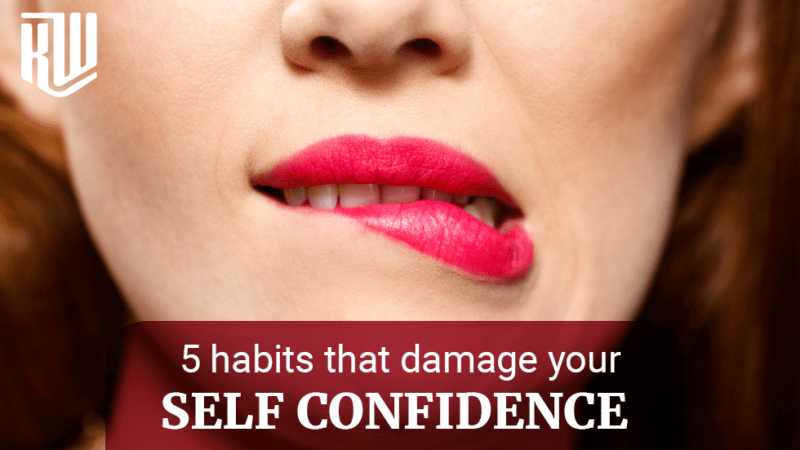I find that many of us know what habits we can implement to maintain (or gain) self-confidence, but what about the things we do, maybe even unconsciously, that damage our self-confidence?
Going Against Ourselves
One of the main ways that we damage our self-confidence is by going against ourselves. Our confidence drops when we do things that we don’t want to do, and we find ourselves asking, “what am I doing? I don’t want to do this!”
When we’re doing things that align with our morals and values, our needs and wants, our negotiables and non-negotiables, we’re walking in who we are.
Our actions are the greatest determiner of our self-confidence.
When you do those great things that you know you’re good at it. You’re like, “Man, I’m killing it today.” You walk taller. You walk smarter. You’re just more kind. You’re in your morals and values, your needs and wants negotiables, and non-negotiables.
We all need a North Star to guide our behavior. And the more we follow those values in ourselves, the more self-confidence we have.
Posture
Our posture has a significant effect on how we think and feel about ourselves.
For most people, their posture is, frankly, not very good. Just walk around. In addition look at how many people walk with their eyes down. Looking at the ground. Shoulders slumped, crossed over, standing there with their arms crossed.
Above all, To instantly boost your self-confidence, get your shoulders back. Get your chin tucked in because I would tend to walk like this. And so I worked on it.
And it’s incredible. You will feel a complete shift in your body. And for those of you, try it right now. Just try sitting up straight.
Thinking vs. Feeling Positive
Many of us also struggle with thinking positive vs. feeling positive. Similarly, we can say affirmations, but if we haven’t learned how to attach a feeling behind the words, the affirmations often don’t stick.
The way our brain works, we feel, almost always, before we think. However, the key to an affirmation is to feel it. Not just think it or say it.
With affirmations, it’s essential to focus on what feeling comes up in your body as you’re stating the affirmation in the present tense.
If you’d like a copy of the Feelings Wheel to help you on your journey towards self-confidence, you can download one for free.
Think Negative To Think Positive
When we use positive thinking to mask the negative feelings we’re experiencing; we find ourselves unable to utilize that strategy because thinking can’t cover up the feeling – we have to let ourselves feel the underlying feeling first. No amount of thinking can help us skip that step.
Doing the healing work to create a positive feeling that correlates to positive thinking is the answer to overcoming our negative feelings.
To overcome our negative feelings, we have to realize what they are and where they originated from feeling positive. The best way to do this is to notice a negative thought or feeling that you commonly have. Sit in it for a moment, and as you think, ask yourself, what am I feeling? Where in my body am I feeling it? See what comes up.
You can quickly jot this down in the notes section of your phone if you’re on the go. That way, when that thought reappears the next day or the next week, you can keep track of the feelings associated with that thought.
As you become more aware of the feelings and the thoughts, you can grow your list as you start to write down as many negative thoughts and feeling patterns as you build a list of what you’re noticing.
The second step is to plan 10-15 minutes of alone time and look at one negative thought and feeling pattern from the list. Then, while you ground yourself in your chair or where you are sitting, let the feelings come up, and then ask yourself, “When was the last time I felt these feelings?”
Let whatever needs to come uprise to the surface of your awareness and write it down.
Then, ask yourself, “When was the last time I felt this?” add the answer to your notes.
Your questions will originate in childhood and bring up a specific memory of the actual event that created these negative thoughts and feelings.
However once we know the original wounding, we can empower ourselves to give it back to where it came from. Usually, these are our primary caregivers, but not always; it could be a sibling, extended family, or a teacher.
Those feelings and thoughts aren’t ours to carry anymore. Instead, we can visualize ourselves giving them back to the originator. As children, we lacked the appropriate boundaries and accepted the false truth as our truth, and it became part of us.
But now we have the opportunity to no longer carry those negative thoughts and feelings with us into the present moment, and we can release ourselves and be free from the pain that we’ve been carrying for them all these years – it was never ours.
It’s important to remember that we must think negatively to think positively. If we try and override negative thoughts with positive ones without focusing on the negative feelings we are trying to cover up, we can create dis-ease and illness in our bodies.
Not Saying No
Not saying no is one of the most significant habits we all have. When we don’t say no, we relive those childhood feelings when we weren’t allowed to say no. In other words when we use what we learned in the last habit to give back our parents’ feelings, we don’t have to carry it anymore.
Conclusion
When we stay true to our morals and values, needs and wants, negotiables and non-negotiables, our confidence skyrockets; if we find ourselves saying yes when we want to say no, then our confidence can plummet. These habits take time to build, so remember to give yourself grace at being perfectly imperfect as you implement them into your journey of self-confidence.

Are You Tired of Feeling Like You’re Not Good Enough?
Do you feel like no one will ever love or accept you unless you are perfect?
You are not alone. We’ve all felt this way at some point in our lives. For instance, it doesn’t have to be this way. It is possible to overcome these feelings and live a life full of self-love and acceptance.
Learn the seven characteristics of high self-love and how it can change your life for the better. In addition, Stop feeling lonely, rejected, or like an outsider in this world.
This masterclass provides the knowledge, skills, and tools for overcoming low self-esteem and accepting who we are as individuals – flaws included!
By the end of the class, participants will learn to take control of their lives by learning a simple process to stop negative thoughts.
That same process will show you how to turn feelings of loneliness, rejection, and emotional wounds from the past into unshakeable self-confidence.
The result is an individual who feels confident in themselves while also embracing their perfect imperfections.
Imagine how exciting it will be to embrace change without fear; take risks with ease; communicate your needs and wants decisively, and simply shrug off attempts by others to judge or criticize you.
Get started on changing your life today by signing up for our online masterclass “How To Love And Accept Your Perfect Imperfections!” TODAY!





